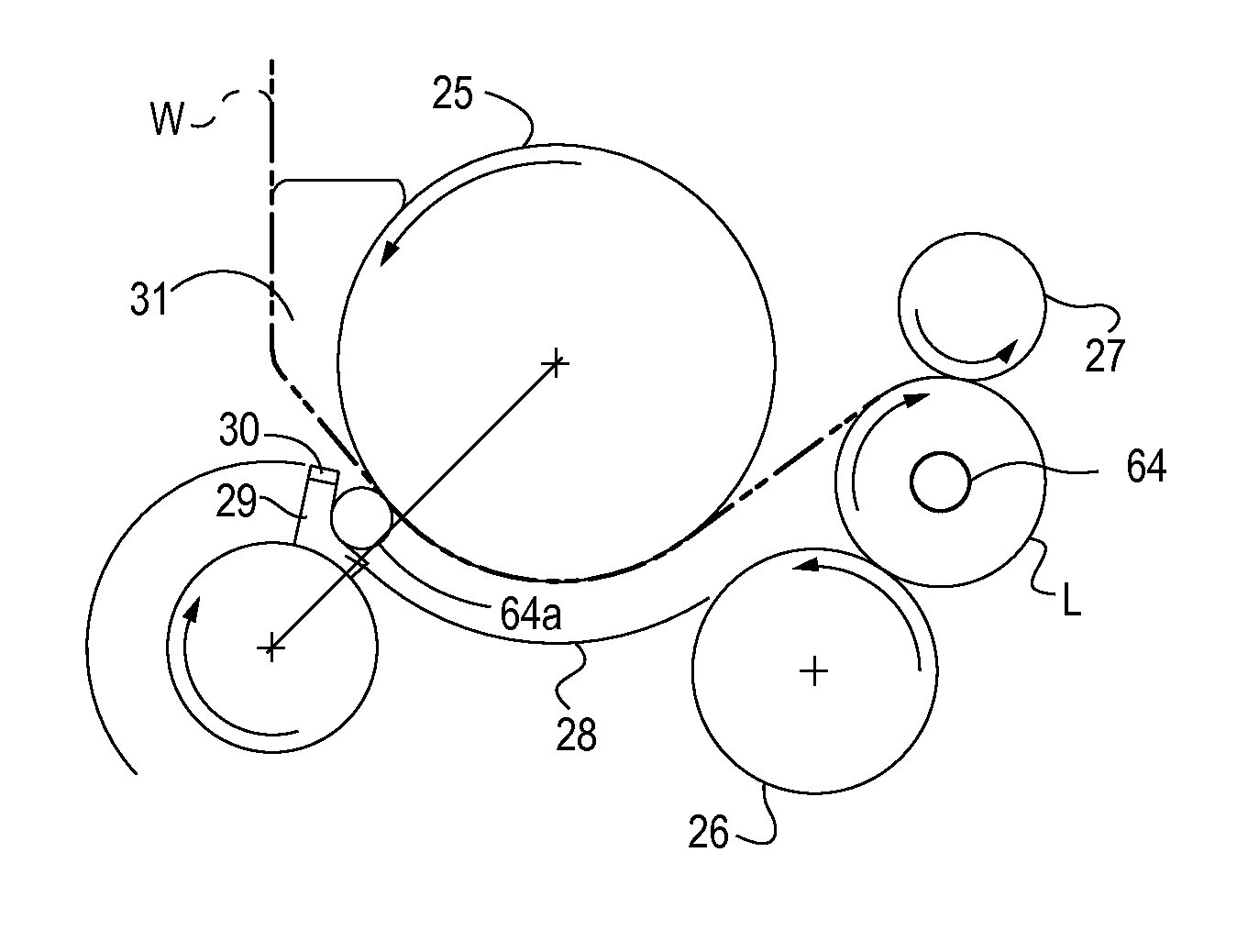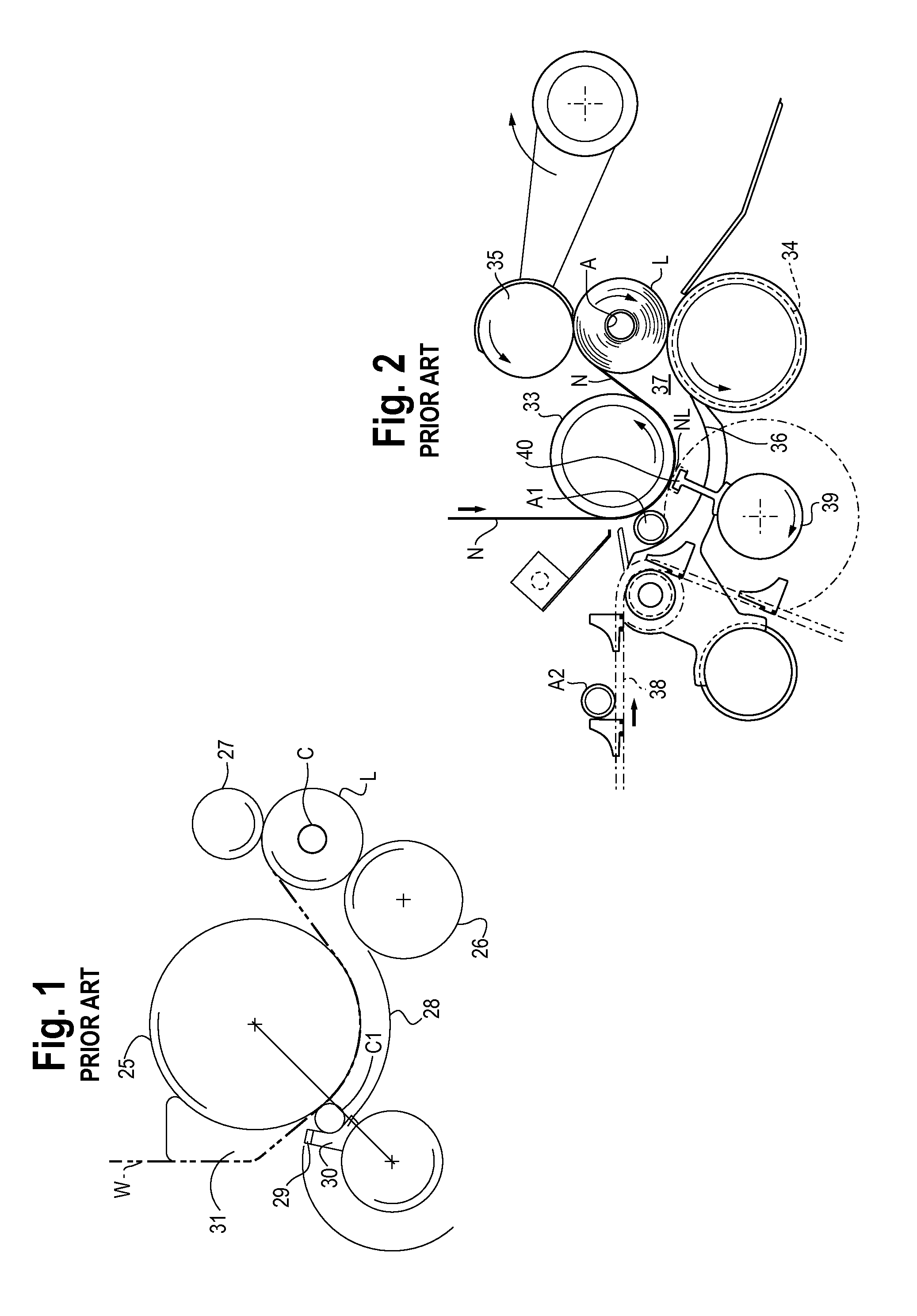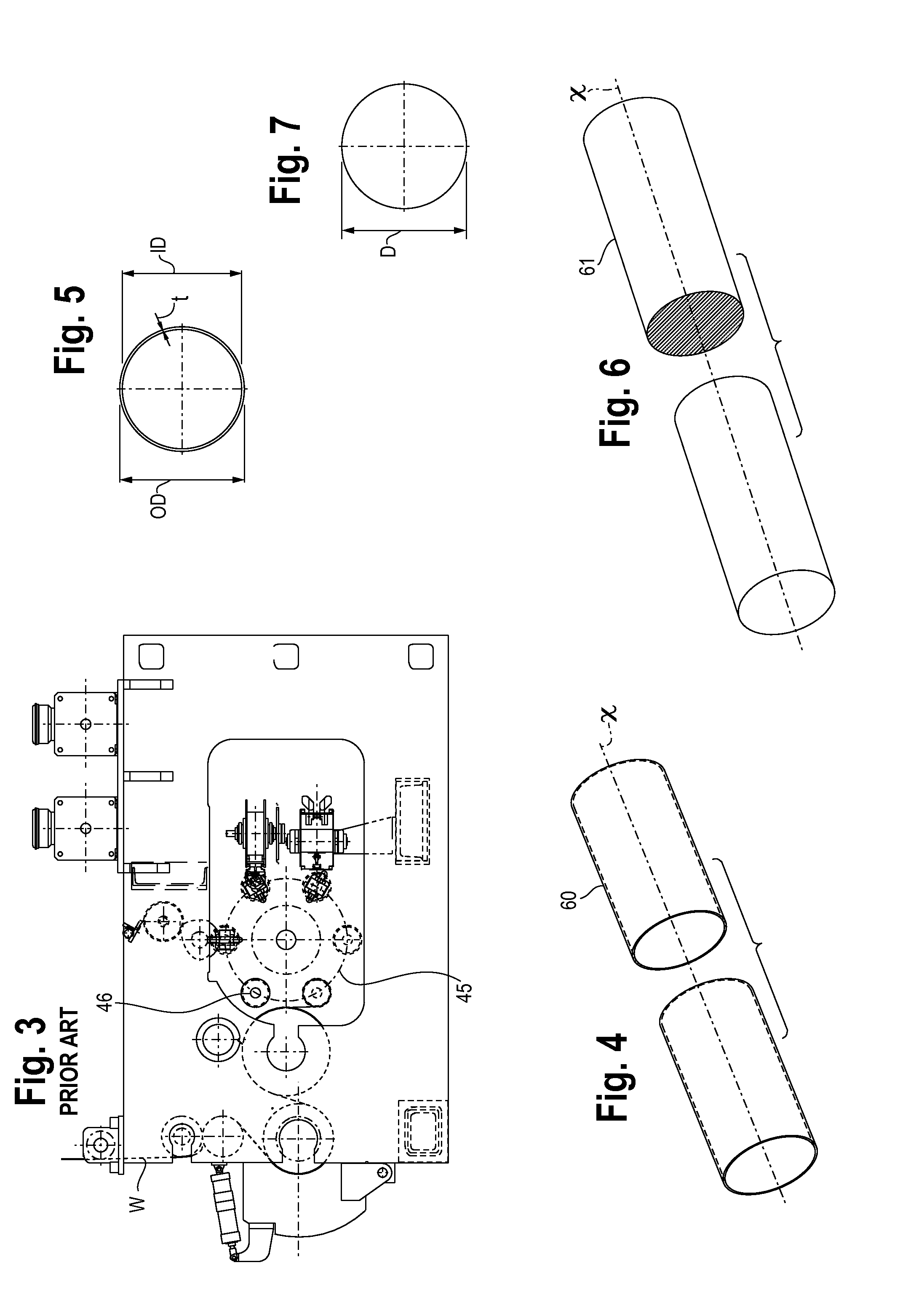Turret winders suffer from the same drawbacks in both coreless production and production with cores.
They cannot produce very firm products because their only control is incoming web tension.
Higher web tension will make a firmer log, but also correlates with more frequent web blowouts due to
bursting of perforations or tearing from defects along the edges of the web.
Also, they cannot run high speeds at very wide widths due to the slenderness of the mandrel inside the log which allows excessive vibration.
Lastly, they cannot ran high cycle rates due to the time in the cycle required to index the
turret, decelerate the log, and then remove the log from the mandrel.
They thus are subject to the same limitations as surface winders that use rigid mandrels and have a relatively narrow operating window: logs wound too tight (high firmness) cannot be stripped off the mandrel due to the resistance induced by high interlayer pressure, and logs wound too loose (low firmness) may
telescope or crumple when log stripping is attempted.
Though these systems achieve the goal of having no core, the products also have no hole, and therefore cannot be used with the universal and nearly ubiquitous dispensers that require a hole for a shaft to pass through.
Though this
system achieves the goal of having no core, it has little material savings because of the separator material, glue to attach the separator material, and the likely wastage of the
nucleus.
Also, this approach does not overcome the narrow product range problem.
The
nucleus cannot be pushed out of loosely wound rolls because the rolls
telescope severely instead.
And the
nucleus cannot be pushed out of tightly wound rolls because its resistance, induced by the high interlayer pressure, is too great.
The major difficulty in using vacuum is the
porosity of the tissue web, which allows a large volume of air to flow through it.
The use of vacuum mandrels at a reasonable production speed is limited to large
diameter mandrels and products with large diameter
hole size, typically more than 48 mm, and narrow web widths, typically less than 2.6 m. Vacuum is also a poor solution when acting directly on tissue webs because infiltrating dust clogs the
system and deteriorates the performance over time.
Cleaning the
system out is laborious and requires substantial
machine down time.
These means are employed because high tack glue makes the extraction of the mandrel from the log more difficult.
Column 2, lines 43-48 explain that these means are simply not reliable enough to run at high speed.
However, using split mandrels increases the
machine complexity, cost, and floor space required, relative to running with cores.
The various extra mechanisms also reduce the
sight lines into the machine and hamper
accessibility for operation and maintenance.
The mandrel washers also increase the cost, machine complexity, floor space, and maintenance effort, relative to running with cores.
. . debris would accumulate on the extractable mandrels” suggest that the system allows tearing and other damage to occur within the log during mandrel extraction.
While the devices may eliminate the need for transfer glue and mandrel washers, the utility and efficiency of the system are hampered by extremely precise timing requirements and
inertia of mechanical actuators that
restrict its operation to relatively
low speed.
However, oscillating, deformable, and compliant accommodations are not predisposed to operation at high speed without premature wear and failure.
These requirements tend to increase the machine cost, parts cost, and level of operator skill that is necessary.
Additionally, in all cases the
actuator moving the log or the mandrel is laterally offset from the mandrel centerline, so large extraction / strip forces produce large moment loads on the guide tracks for the clasp pulling the mandrel or the
paddle pushing the log.
Substantial frames, brackets, and guide ways are required to oppose this moment, which increases the cost and space required, and reduces the practical speed at which they operate.
And it is a frequent complaint that the guide ways
wear out prematurely.
However, plastic core tubes are not used in bathroom tissue or kitchen towel due to the significantly higher cost over conventional
cardboard cores, and also because the plastics are not produced in the paper mills which typically make both the
cardboard and tissue products from wood pulp and recycled paper.
These drawbacks constitute the primary reasons coreless production remains a niche market, despite its intrinsic appeal.The maximum cycle rates are very low, due to the log stripping sequence.The precision rigid mandrels used are expensive, as are their coatings which wear off.Mandrels made from metals are heavy.
Therefore, they have relatively high
mass and polar
inertia, which present the following problems:The high
mass causes parts on the inserter and infeed portion of the cradle to deteriorate rapidly due to impacts and / or abrasion when running high speed.The high
mass and polar
inertia cause the mandrel to
resist the very sudden changes to its translational and rotational velocity required when it is pushed into the channel between the upper roll and the stationary rolling surface of the rewinder.
Failure of the mandrel to properly accelerate causes poor and unreliable web transfers.
The worst case is an outright failure to transfer, which crashes the machine.The high mass and polar inertia cause the mandrel to
resist the very sudden changes to its translational and rotational velocity required when it leaves the stationary rolling surface and enters the nip between the upper and lower rolls.
Failure to properly accelerate causes
poor quality winding.The worst case is that the mandrel slides through the nip out of control and crashes the machine.The high mass and stiffness of these mandrels combine to give them the capacity to do serious damage to other parts of the machine during a high speed
crash.Though mandrels made of
fiber-reinforced
polymer composites have
reduced mass and polar inertia, relative to
metal mandrels, they present the following problems:They are very expensive.
This comes into play not only regarding the initial purchase of the machine, but also its ongoing operating costs because the mandrels have a finite life and must be replaced when worn out or broken.During severe crashes
carbon fiber composite mandrels break into pieces.
The debris is akin to splinters and can be dangerous to operators cleaning them up and to end users if bits get into the finished product.The
high stiffness of these mandrels gives them the capacity to do serious damage to other parts of the machine during a high speed
crash.
The goal of using these very expensive composite mandrels is to run faster, so the damage caused is often just as great as with a heavier
metal mandrel running slower.Coreless surface winders can successfully run only a
narrow range of products:Low firmness (loosely wound) products lack the radial stiffness to support the relatively heavy mandrel during high speed winding.
They also lack the interlayer pressure to
resist telescoping during mandrel extraction or log stripping.
And they lack the column strength to resist localized axial collapse (crumpling like an accordion) during mandrel extraction or log stripping.Very firm (tightly wound) products have excessive interlayer pressure and can stall the
actuator during mandrel extraction or log stripping.Only a
narrow range of products has adequate firmness to support the relatively heavy mandrels during winding and resist collapse during stripping, and high enough interlayer pressure to prevent telescoping during stripping, but also low enough interlayer pressure that the stripper does not stall.Web transfer in coreless rewinders is done at relatively low speeds, compared to machines running with conventional cores.
Web transfer is less reliable with low tack glues at high speeds.The mandrels have higher mass and inertia than cores, and thus cannot do abrupt speed transitions like cores (as described above), so the transfer sequence is more difficult to control and less reliable.Coreless machines have higher operating costs due to more frequent maintenance, replacement of damaged mandrels, replacement of worn
specialty parts, and higher level of operator skill required.Though machines can be switched between core and coreless operation, it is a major
changeover effort, not a simple grade change.Even after the finished roll is successfully produced, there is still the danger of it internally unraveling while in transit to the
end user if the interior
tail is not secured.
The issues appear complex, because a solution in one area can cause difficulty in another area.
But, how could such a mandrel ever be successfully extracted from a wound log?
 Login to View More
Login to View More 


